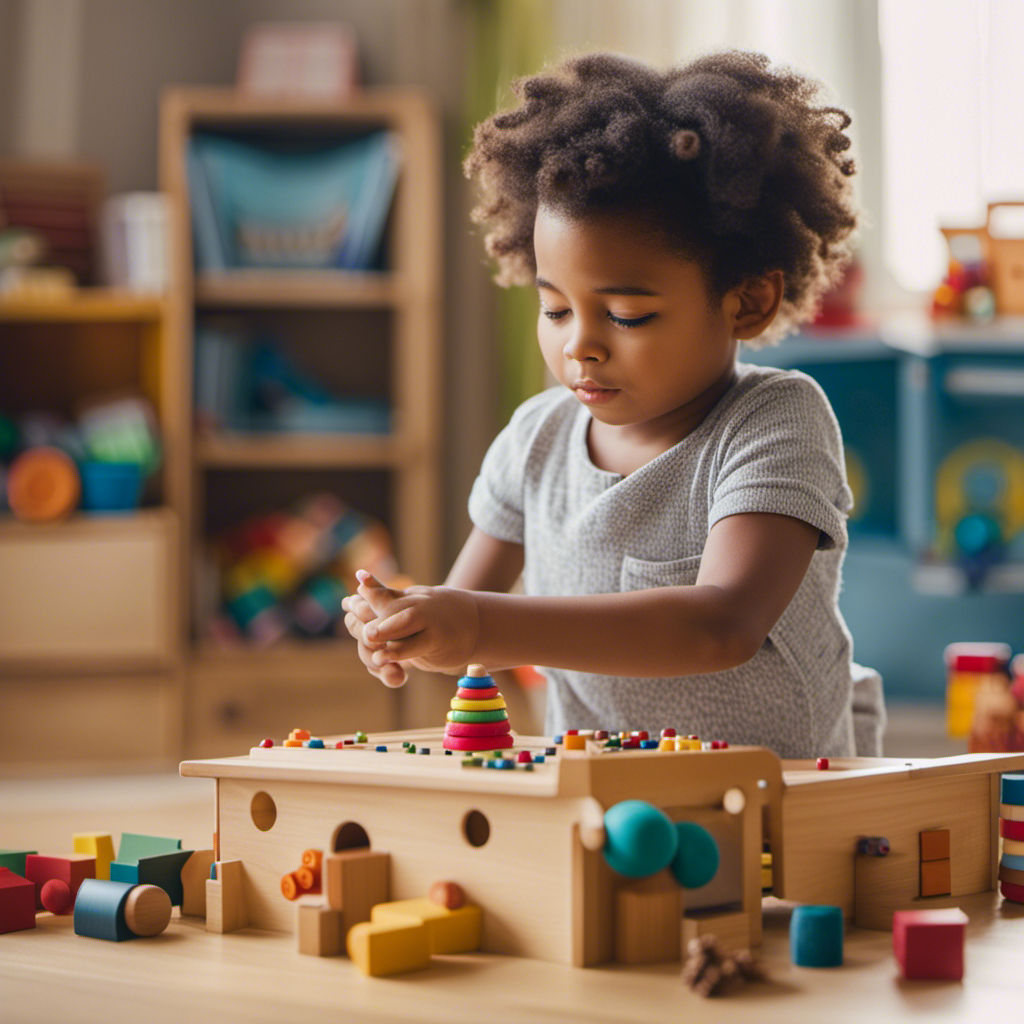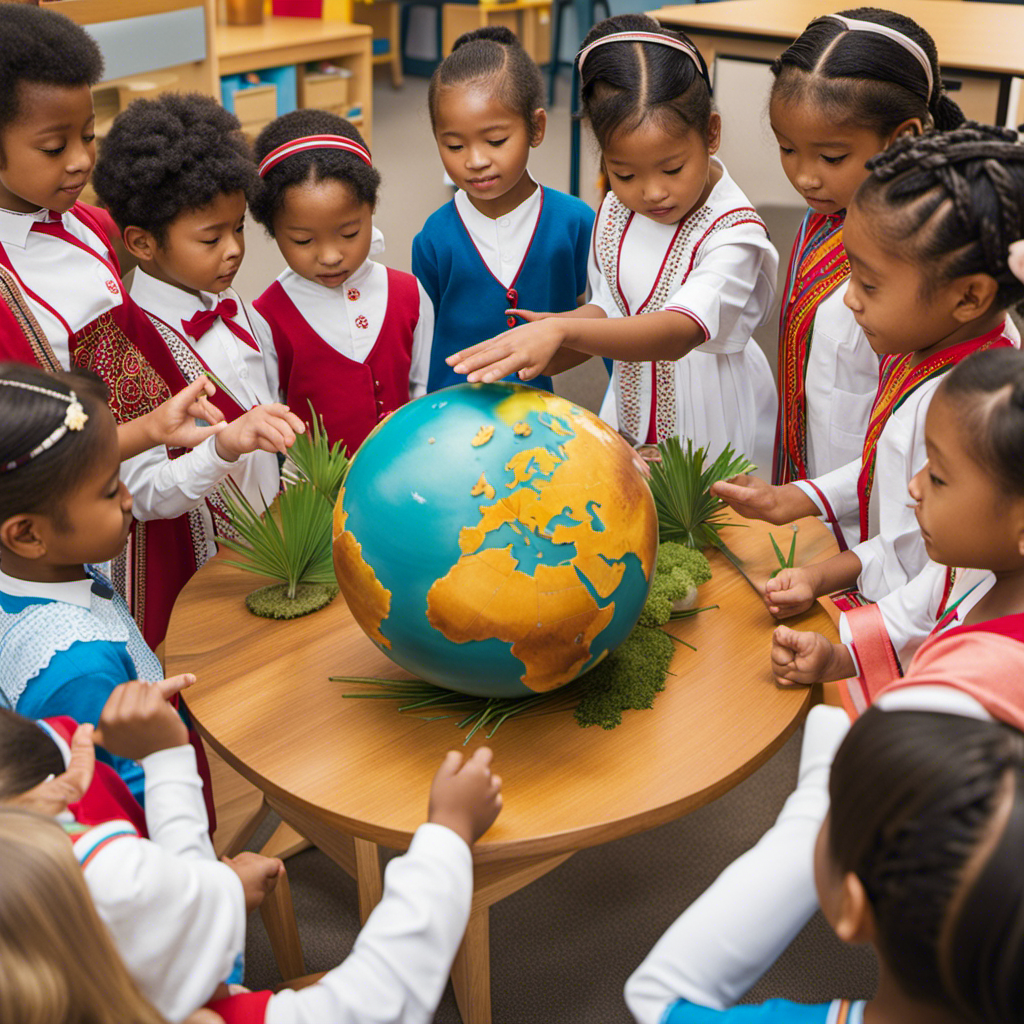Hello!
So, you know how kids can sometimes be a bit possessive when it comes to their toys?
Well, I’m here to tell you why we don’t force them to share in a Montessori environment.
It’s all about promoting autonomy and independence, while also teaching important life skills like empathy and conflict resolution.
Trust me, the Montessori approach to toy sharing is all about fostering personal growth and development.
So, let’s dive in and explore why forcing kids to share might not be the best idea after all.
Key Takeaways
- Montessori promotes autonomy, independence, and self-expression
- Toy sharing in Montessori fosters social and emotional skills development
- Montessori encourages nurturing independence and responsibility through toy sharing
- Montessori enhances conflict resolution and communication skills
The Importance of Autonomy in Montessori
In Montessori, it’s important for you to have autonomy and make choices for yourself. The Montessori approach believes in promoting self-expression and fostering decision-making skills. Children are encouraged to explore their interests and express themselves freely.
This is done through a variety of activities and materials provided in the Montessori environment. By allowing children to choose what they want to work on, they develop a sense of independence and confidence in their abilities. They learn to make decisions based on their own interests and preferences. This autonomy helps them become self-reliant and self-motivated learners.
As we encourage children to make choices for themselves, they also learn to respect the choices of others. This sets the foundation for promoting independence in toy sharing, where children learn to negotiate, take turns, and consider the needs and wants of others.
Promoting Independence in Toy Sharing
Encouraging children to independently choose when to share their toys is a key aspect of the Montessori approach. In Montessori classrooms, promoting independence and fostering collaboration are fundamental principles.
By allowing children the freedom to decide when and how to share their toys, we empower them to develop important social and emotional skills. Instead of forcing sharing, we provide a supportive environment that encourages children to communicate, negotiate, and problem-solve with their peers.
This approach not only respects each child’s autonomy but also promotes a sense of ownership and responsibility for their belongings. It teaches children the value of empathy and helps them develop meaningful relationships based on mutual trust and understanding.
Understanding the Montessori approach to sharing goes beyond simply enforcing rules; it involves nurturing a child’s innate ability to navigate social interactions and build meaningful connections with others.
Understanding the Montessori Approach to Sharing
By allowing your child the freedom to decide when and how to share their toys, you empower them to develop important social and emotional skills. In the Montessori approach, we believe in promoting self-expression and encouraging problem-solving through independent decision-making.
Here are five reasons why this approach is beneficial for your child’s development:
- Fosters a sense of ownership and responsibility for their belongings
- Builds confidence and self-esteem as they make choices and solve conflicts
- Enhances their communication skills by learning to express their needs and desires
- Teaches empathy and understanding as they navigate sharing with others
- Develops critical thinking and problem-solving abilities in finding fair solutions
By prioritizing these skills, we create an environment that supports your child’s holistic growth.
Now, let’s delve into another aspect of the Montessori method – encouraging respect for personal space.
Encouraging Respect for Personal Space in Montessori
Respecting personal space in the Montessori approach allows your child to develop a strong sense of boundaries and autonomy. By promoting personal boundaries, the Montessori method recognizes the importance of honoring each child’s individuality and self-expression.
In a Montessori environment, children are encouraged to explore their surroundings and engage in activities at their own pace, while also respecting the personal space of others. This fosters a sense of independence and self-confidence, as children learn to navigate their surroundings and interact with others in a respectful manner.
As children grow and develop in this environment, they begin to understand the importance of personal space and boundaries, which sets the foundation for healthy relationships and social interactions.
Now, let’s explore how the Montessori approach further supports the development of empathy and emotional intelligence through toy sharing.
Developing Empathy and Emotional Intelligence Through Toy Sharing
When you share toys with others, you are developing empathy and emotional intelligence. This act of sharing teaches us to consider the feelings and needs of others, helping us build strong social skills and promoting emotional growth.
Here are four ways in which toy sharing can evoke an emotional response:
-
Kindness: Sharing toys shows kindness towards others, fostering a sense of compassion and understanding.
-
Empathy: By sharing toys, we learn to put ourselves in someone else’s shoes, developing the ability to understand and share their feelings.
-
Patience: Sharing requires waiting for our turn, teaching us patience and self-control.
-
Cooperation: Sharing toys encourages cooperation and teamwork, as we learn to play together harmoniously.
Building Social Skills Through Self-Directed Toy Sharing
Engaging in self-directed toy sharing helps children build social skills and emotional intelligence.
When children are given the freedom to choose when and with whom they share their toys, they are actively participating in self-directed learning. Through this process, they begin to understand the importance of taking turns, negotiating, and compromising with others.
These experiences contribute to their social development by teaching them how to interact and communicate effectively with their peers.
By allowing children to make their own decisions about sharing, we are also nurturing their sense of ownership and responsibility with toys.
This will be further explored in the subsequent section, where we discuss the benefits of fostering a sense of ownership and responsibility in children when it comes to their toys.
Nurturing a Sense of Ownership and Responsibility With Toys
Taking ownership of their toys and being responsible for their care allows children to develop a sense of pride and independence. When children have a sense of ownership, they feel a deeper connection to their belongings. They learn to value and take care of their toys because they understand that they are responsible for them. This sense of ownership fosters a sense of responsibility as well.
Children learn that they must take care of their toys and keep them in good condition. They also learn to clean up after themselves and put their toys away when they are done playing. This sense of responsibility extends beyond just their toys and can be applied to other areas of their lives. It is an important skill that will benefit them as they grow older.
Fostering Collaboration and Cooperation in Montessori Environments
To foster collaboration and cooperation in Montessori environments, you can encourage children to work together towards common goals. By providing opportunities for group activities and projects, children can develop social skills and learn how to effectively communicate and cooperate with their peers.
In these collaborative settings, children are encouraged to share their ideas, listen to others, and work together to solve problems. This not only promotes a sense of community within the classroom but also helps children develop important life skills that will benefit them in the future.
By fostering collaboration in Montessori environments, children learn the value of teamwork and the importance of respecting and appreciating the contributions of others.
Transitioning to the next section, exploring the role of observation in toy sharing, we can see how children can learn from observing others’ interactions and behaviors.
Exploring the Role of Observation in Toy Sharing
By observing how their peers share toys, children can learn important social skills and develop a greater understanding of cooperation and empathy. Through the role of observation, children in Montessori environments have the opportunity to witness firsthand the benefits of unstructured play and the positive effects it has on their social development. Here are three key benefits of observing toy sharing among peers:
-
Learning by Example: By watching others share toys, children learn how to take turns, negotiate, and compromise, which are essential skills for navigating social interactions.
-
Developing Empathy: Observation allows children to understand and empathize with the feelings and needs of others, fostering a sense of compassion and understanding.
-
Building Communication Skills: By observing how their peers communicate and collaborate during toy sharing, children can improve their own communication skills, learning to express their needs and desires effectively.
Through observation, children gain valuable insights into the importance of toy sharing and the skills it helps them develop. This lays the foundation for supporting individual development and growth through toy sharing, as we will explore in the subsequent section.
Supporting Individual Development and Growth Through Toy Sharing
When you observe your peers sharing toys, you can learn valuable lessons about cooperation, empathy, and communication. Encouraging self-expression through toy sharing allows children to express their individuality and preferences.
By sharing toys, children have the opportunity to showcase their interests and talents, fostering a sense of identity and self-esteem. Additionally, toy sharing supports problem-solving skills as children navigate sharing resources, negotiating playtime, and resolving conflicts that may arise. Through these experiences, children develop critical thinking abilities and learn to find mutually beneficial solutions.
As they communicate their needs and desires, they also learn to listen and empathize with others, building essential social and emotional skills. Transitioning to addressing conflict resolution in Montessori toy sharing, it is important to create a supportive environment that encourages children to navigate conflicts independently.
Addressing Conflict Resolution in Montessori Toy Sharing
Teaching empathy through sharing is an essential aspect of promoting social and emotional development in children. By encouraging them to share their toys and belongings, we can help them develop an understanding and appreciation for the feelings and needs of others.
At the same time, it is crucial to respect their individual autonomy in sharing, allowing them to decide when and how they want to share. This approach promotes cooperation and communication among children, fostering a positive and inclusive learning environment.
Teaching Empathy Through Sharing
If you want to teach empathy, encourage children to share toys willingly, rather than forcing them to do so. This approach promotes independence and allows children to develop their own sense of empathy through personal experiences.
Here are some key points to consider when teaching empathy through sharing:
-
Create a supportive environment:
-
Foster a sense of community where children feel safe to express their emotions and needs.
-
Encourage open communication, active listening, and problem-solving skills.
-
Model empathetic behavior:
-
Demonstrate empathy by acknowledging and validating children’s feelings.
-
Use language that promotes understanding and empathy, such as ‘How do you think your friend feels when you share with them?’
Individual Autonomy in Sharing
Encouraging voluntary sharing empowers children to develop their own empathy skills and promotes individual autonomy in sharing.
When it comes to sharing, there is often a tension between autonomy and conformity. On one hand, children should be able to make choices about sharing based on their own needs and desires. On the other hand, societal expectations play a role in teaching children the importance of sharing and considering the needs of others.
Balancing these two aspects is crucial in fostering a healthy understanding of sharing. By allowing children to make their own decisions about sharing, they learn to navigate this delicate balance. This not only promotes their autonomy but also helps them develop a sense of empathy towards others.
Ultimately, by empowering children to make their own choices in sharing, we set the stage for promoting cooperation and communication without imposing strict rules.
Promoting Cooperation and Communication
Promoting cooperation and communication among children is essential for creating a harmonious and inclusive sharing environment. In a Montessori setting, the focus is on developing problem-solving skills and promoting social interaction. By encouraging children to work together and communicate effectively, they learn the importance of collaboration and empathy.
One effective way to foster cooperation and communication is through structured activities that require teamwork. For example, a simple activity like building a tower using blocks can teach children the value of sharing ideas, taking turns, and listening to others. This not only enhances their problem-solving abilities but also strengthens their social skills.
To illustrate this, here is a table showcasing the benefits of promoting cooperation and communication:
| Benefits of Promoting Cooperation and Communication |
|---|
| Develops problem-solving skills |
| Enhances social interaction |
| Encourages empathy |
| Fosters teamwork |
| Improves communication skills |
Embracing the Benefits of Unstructured Play and Toy Sharing in Montessori
Embracing the benefits of unstructured play and toy sharing in Montessori allows children to develop important social skills and learn at their own pace.
-
Enhanced creativity: Unstructured play allows children to use their imagination and think outside the box. They can create their own games and scenarios, fostering creativity and problem-solving skills.
-
Improved communication: When children engage in unstructured play, they have the opportunity to interact with their peers, negotiate, and express their thoughts and feelings. This promotes effective communication skills and the ability to navigate social interactions.
-
Increased empathy: Toy sharing in Montessori encourages children to understand and respect the feelings and needs of others. They learn to take turns, compromise, and practice empathy, which are vital skills for building positive relationships.
-
Independent learning: Unstructured play gives children the freedom to explore and discover on their own. They can choose activities that interest them, leading to self-motivated learning and a sense of autonomy.
Frequently Asked Questions
What Are Some Strategies for Promoting Independence in Toy Sharing in Montessori?
Promoting independence and fostering autonomy in toy sharing is essential in Montessori. By allowing children the freedom to choose when and with whom they share their toys, we empower them to develop their own sense of ownership and responsibility.
Encouraging open communication and teaching conflict resolution skills also play a crucial role. Montessori believes that forcing kids to share can hinder their development and understanding of boundaries, so instead, we focus on guiding and supporting their growing independence.
How Does the Montessori Approach to Sharing Differ From Traditional Approaches?
In the Montessori approach, sharing is seen as a natural development rather than something that should be forced upon children. Unlike traditional approaches, which may emphasize the need for children to share their toys, Montessori encourages independence and autonomy in play.
How Can Montessori Environments Encourage Respect for Personal Space During Toy Sharing?
Promoting autonomy and teaching boundaries are key in Montessori environments when it comes to toy sharing. By respecting personal space, children are encouraged to develop a sense of ownership and responsibility over their belongings.
Instead of forcing kids to share, we focus on teaching them to take turns and negotiate with their peers. This approach fosters empathy and understanding, as children learn to respect each other’s boundaries and develop important social skills that will benefit them throughout their lives.
What Are Some Ways That Toy Sharing in Montessori Can Help Develop Empathy and Emotional Intelligence?
Developing empathy through sharing toys in Montessori can have a profound impact on a child’s emotional intelligence. By allowing children to freely choose when and how they share, they learn to understand and respect the feelings of others.
This process helps them develop empathy, as they begin to recognize that their actions can affect others’ happiness.
In addition, engaging in cooperative play and problem-solving during shared playtime can further enhance their emotional intelligence by teaching them valuable skills like communication, negotiation, and compromise.
What Are the Benefits of Unstructured Play and Toy Sharing in Montessori?
The benefits of unstructured play and toy sharing are numerous.
Unstructured play allows children to explore their creativity and problem-solving skills, fostering independence and self-confidence. It also promotes social skills, as children learn to navigate conflicts and negotiate with their peers.
Additionally, allowing individual autonomy in toy sharing teaches children the importance of respecting others’ possessions and boundaries.
Conclusion
In conclusion, the Montessori approach to toy sharing highlights the importance of autonomy and independence in a child’s development. By allowing children to choose when and with whom they want to share their toys, we are promoting a sense of respect for personal space and fostering empathy and emotional intelligence.
Just like a river flowing effortlessly, Montessori embraces the benefits of unstructured play and toy sharing, allowing children to grow and develop at their own pace.









